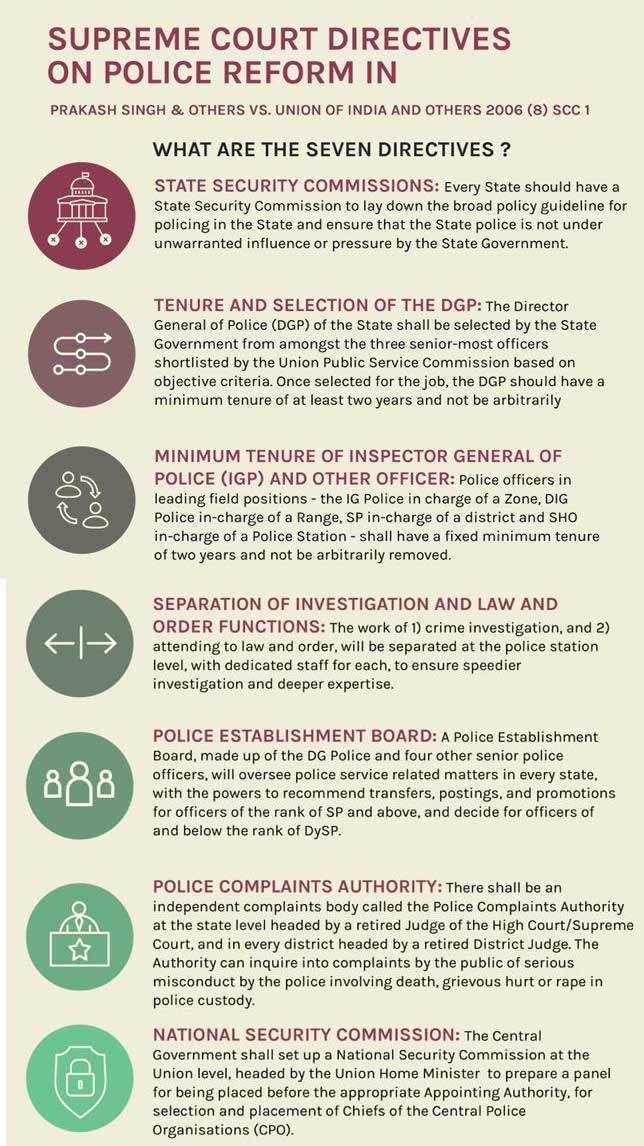- Home
- Prelims
- Mains
- Current Affairs
- Study Materials
- Test Series
 Latest News
Latest News
 EDITORIALS & ARTICLES
EDITORIALS & ARTICLES
Police reforms has been on the agenda of Governments almost since independence but even after more than 70 years, there is a cry for police reforms. . Examine the need of Police Reforms in India to effectively deal with the new forms of crime and criminals, uphold human rights and safeguard the legitimate interests of one and all.
In India, state police forces are responsible for maintaining law and order and investigating crimes, central forces assist them with intelligence and internal security challenges (e.g., insurgencies). Expenditure on police accounts for about 3% of the central and state government budgets.
The legal and institutional framework governing police matters in India was inherited from the British. The current legal framework, comprising the Police Act 1861 and other state specific laws, is deficient in establishing an accountable police force.
While multiple reform proposals have been recognised by the Government of India and the Supreme Court, such reform has not been achieved or implemented to the desired extent. Therefore, India needs to revise the legal and institutional framework to move towards smart policing.
Police in Indian Democracy
- The primary role of police forces is to uphold and enforce laws, investigate crimes and ensure securityfor people in the country.
- In a large and populous country like India, police forces need to be well-equipped, in terms of personnel, weaponry, forensic, communicationand transport support, to perform their role well.
- Further, they need to have the operational freedom to carry out their responsibilities professionally, and satisfactory working conditions(e.g., regulated working hours and promotion opportunities), while being held accountable for poor performance or misuse of power.
- Police reformsare also necessary periodically, since crimes and insurgencies are changing and becoming more sophisticated.
Challenges Related to Policing in India
- Low Police-Population Ratio: State police forces had 24% vacancies(about 5.5 lakh vacancies) in January 2016. Hence, while the sanctioned police strength was 181 police per lakh persons in 2016, the actual strength was 137 police. Note that the United Nations recommended 222 policemen per lakh population.
- As a result of understaffing, policemen are overburdened with work, which not only reduces their effectiveness and efficiency(resulting in poor investigations), but also leads to psychological distress and leads to pendencies of cases.
- Political Superimposition:According to police laws, both the Central and State police forces are under the control of political executives. Police priorities are frequently changed by political leaders according to the political mood of the state.
- TheSecond Administrative Reforms Commission noted in 2007 that politicians unduly influenced police personnel for personal or political reasons.
- Colonial Legacy:To streamline the country''s police administration after the revolt of 1857, the British enacted the Police Act of 1861. This act does not correspond with the democratic aspirations of the population after 75 years of Republic India.
- Public Perception:The Second ARC has noted that police-public relations are unsatisfactory in India because people view the police as corrupt, inefficient, and unresponsive, and often hesitate to contact them.
- Infrastructural Deficit:Today''s police forces require strong communication support, modern weapons, and high mobility. CAG audits for 2015-16 have found shortages in weapons among state police forces.
- Also, the Bureau of Police Research and Developmenthas also noted a 5% deficiency in stock of required vehicles with the state forces.
- Changing Technology, Challenging Policing:In the next decade, digitalization, hyperconnectivity, and exponential growth of data are expected to accelerate.
- There is a threat to effective policing from the convergence of different domains like bioweapons and cyberattacks.
Looking ahead
- Making the Police a SMART Force:There is a need for making Indian police Strict and Sensitive, Modern and Mobile, Alert and Accountable, Reliable and Responsive, Tech Savvy and Trained.
- Various studies indicate that when police officers treat citizens with dignity, allow them an equal voice in interactionsand are guided by considerations of transparency and accountability, it strengthens people’s compliance with laws, ameliorating conditions for commission of crimes.
- Promoting Community Policing:Increasing community policing makes sense because it involves police and community members working together to solve crime and crime-related issues and also improves people-police relations.
- Setting up Police Complaints Authority:According to the Supreme Court, an independent complaints authority is needed to investigate complaints of police misconduct.
- In accordance with theModel Police Act, 2006, each state must establish an authority made up of retired High Court judges, civil society members, retired police officers, and public administrators from another state.
- Strengthening Cyber-Policing to Combat Cyber-crime:As crime becomes more sophisticated, complex, and transnational, new digital investigative and data management capabilities along with innovative AI-enhanced tools are critical.
- For example, criminal statisticswill have to be updated to adequately capture cybercrime across the country.
- Transparency in Appointments:Police reforms are crucial to hold the structure of the criminal justice system together. The 1861 Act must be amended, in accordance with the Supreme Court’s directives.
- Since the appointment of the director general of police,e The chief of the police in a state ispivotal to the police’s administration, there is a need to devise a transparent and merit based procedure for such appointments.
- Addressing Women Under-Representation:Parliamentary Standing Committee advised states and Union Territories to create a road map for ensuring 33% representation of women in police. It also recommended at least one all-women police station in each district.










 General Studies
General Studies